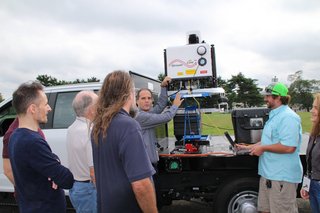My PhD exploits measurements by the Microwave Radar / radiometer for Arctic Clouds (MiRAC) which were performed last year as part of the campaign "Arctic CLoud Observations Using airborne measurements during polar Day" (ACLOUD). Before further analysis I need to develop an algorithm to control and clean the radar measurements of contamination by arti ficial echoes. This is challenging as the radar is a special Frequency-Modulated Continuous Wave (FMCW) radar that is used downlooking from an aircraft to measure clouds. Due to this special radar technique artifacts occur near and aligned to the surface and contaminate cloud measurements.
Thanks to the Travel Grant of the Graduate School of Geosciences I could intensively discuss with Prof. Pavlos Kollias and in general learn more about radar meteorology. Our discussions of the artifact properties lead to the insight that a ltering method of the radar re ectivity, a parameter to measure clouds, is the best and fastest way to exclude the artifacts. Hence, I got motivated to remove the artifacts in all ight measurements by using my lter method. As soon as the artifacts have been removed, the analyses of the radar can begin, but rst, I will analyze the artifacts and the excluded values statistically. Afterwards, I will analyze the interesting surface backscatter and I will compare the cloud environment observed by MiRAC and the ground-based Radar in Ny Ålesund (Svalbard).
In addition to my work I got to know the Stony Brook University - School of Marine and Atmospheric Sciences (SoMAS) and the Brookhaven National Laboratory (BNL). I shared an apartment with Dr. Lukas P tzenmaier (University of Cologne) and Petros Kalogeras (University of Leicester) who also work on radar-related topics and will stay at the SoMAS and BNL until Dec 10 to work on the EarthCARE (Earth Cloud, Aerosol and Radiation Explorer) project with Prof. Kollias. Together, we discussed and worked on Lidar- and Radar-Meteorology each day. Furthermore, we attended in a presentation of a new Lidar-Truck and testing a novel Phase Array Radar. We could also attend a seminar by Prof. Mark A. Miller (Rutgers University) on topic "New Perspectives on Marine Stratocumulus over the Eastern North Atlantic" and a discussion about snow ake observations. I also got to know Damao Zhang (BNL), who will participate in the 2nd (AC)3 Science Conference on Arctic Ampli cation (Nov. 12 - 14) in Bremerhaven and will stay at the Institute for Geophysics and Meteorology at the University of Cologne afterwards.
Leif-Leonard Kliesch
PhD student
Institute for Geophysics and Meteorology
PhD project: "Characterization of Arctic Mixed-Phase Clouds by Airborne Remote Sensing using the novel Microwave Radar/Radiometer for Arctic Clouds (MiRAC)"

